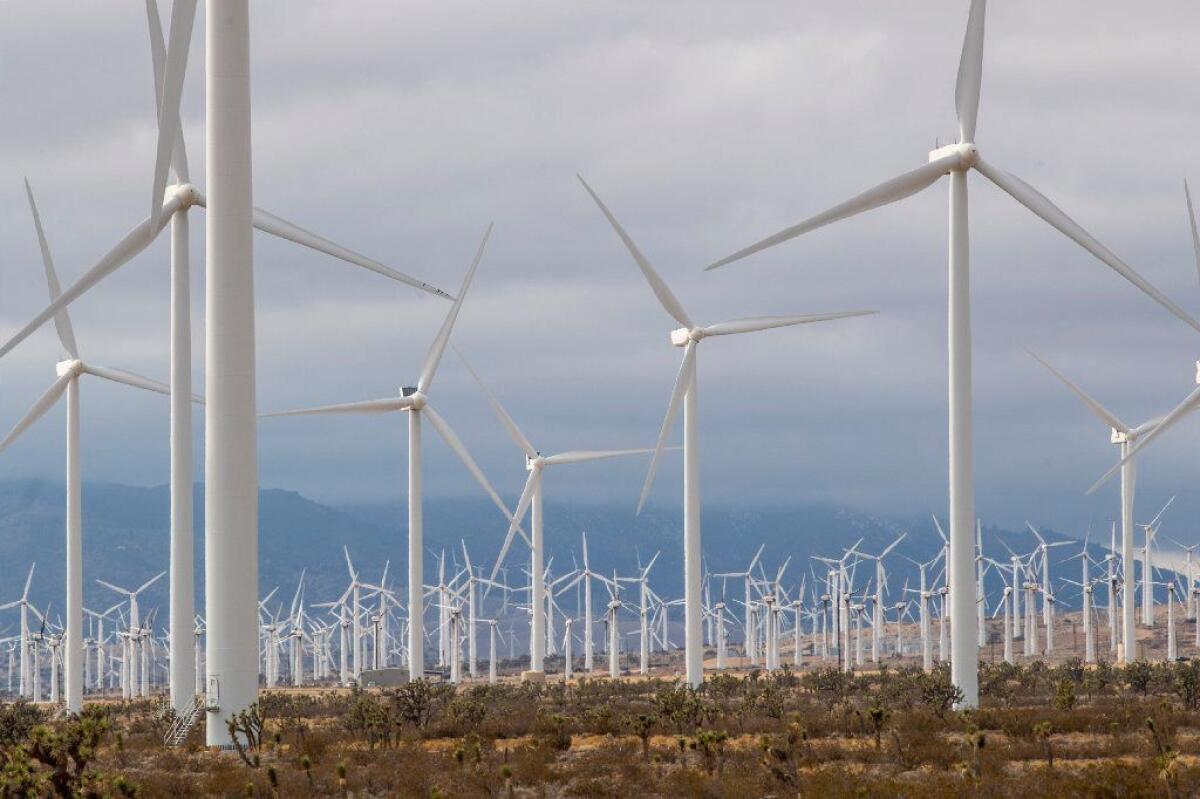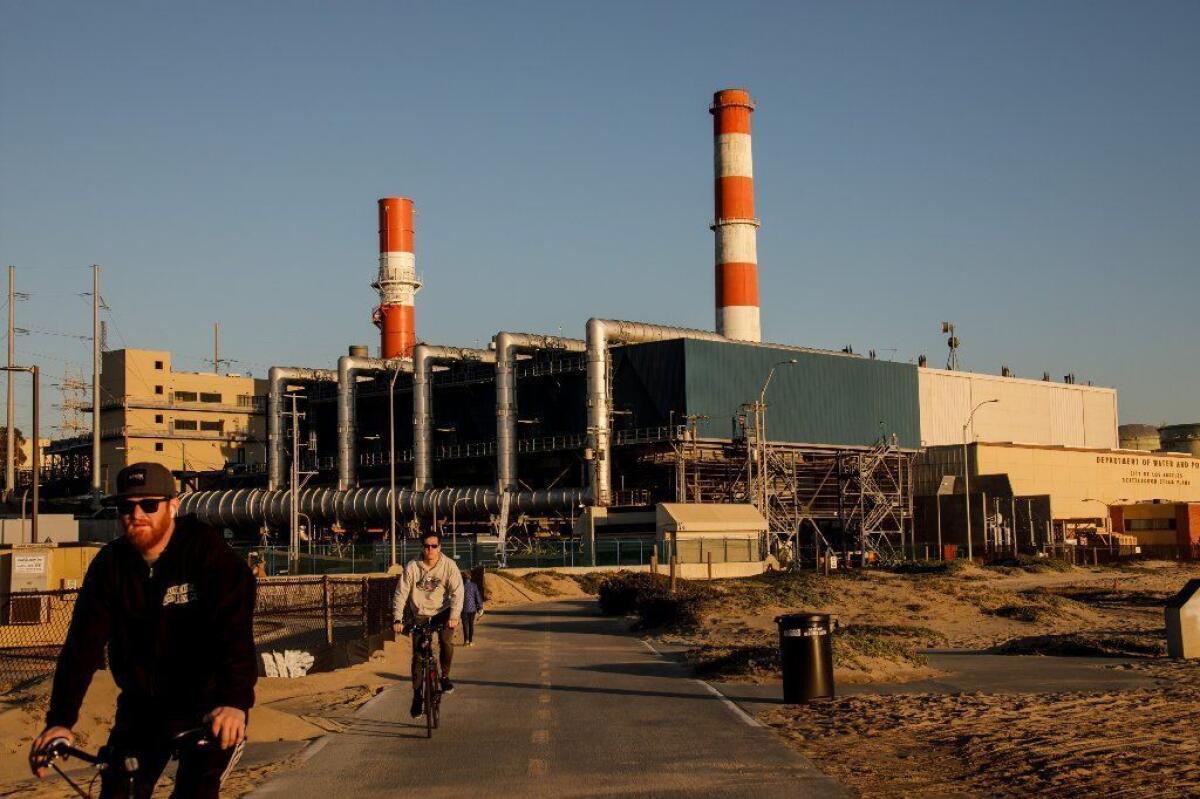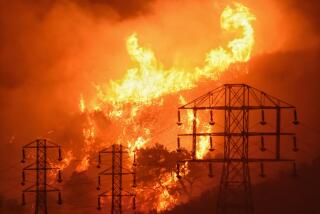Hydropower bill would sabotage California’s clean energy mandate, critics say

- Share via
The Don Pedro hydropower project, just west of Yosemite National Park, has been churning out carbon-free electricity for nearly a century. As the Tuolumne River flows from the Sierra Nevada to the Central Valley, it passes through Don Pedro Dam, spinning four turbine generators.
None of the electricity is counted toward California’s push for more renewable energy on its power grid. A new bill advanced by state lawmakers last week would change that — and it’s being opposed by environmental groups, who say it would undermine the state’s landmark clean energy law by limiting the need to build solar farms and wind turbines.
Under Senate Bill 100, which was signed last year by then-Gov. Jerry Brown, California is required to get 100% of its electricity from climate-friendly sources by 2045. The law has become a model for climate change action in other states, with lawmakers in New Mexico and Washington recently approving similar legislation.
But the details of how to get to 100% still need to be worked out. And now SB 386, which was written by state Sen. Anna Caballero (D-Salinas), is reviving an old fight that’s never been fully resolved.
Central Valley lawmakers have long argued that large hydropower projects should count toward California’s renewable energy goals. From their perspective, excluding existing hydropower facilities forces utilities to buy additional solar and wind energy, raising energy costs for ratepayers in one of the poorest parts of the state.
But environmentalists are loath to encourage the construction of new dams, which they see as destructive projects that drain rivers and kill fish.
Although the era of dam building in California largely ended decades ago, many climate advocates also oppose categorizing existing hydropower as renewable energy. They say the state’s renewable energy program was designed to eliminate fossil fuels and create jobs by supporting the growth of new industries — primarily solar and wind power — not to give utilities credit for facilities already built.
Changing the program now to include existing hydropower plants, they say, would seriously undermine SB 100, delaying by as much as a decade the state’s push to replace gas-fired power plants with solar and wind.
Former state Senate leader Kevin de León, who wrote SB 100, called the new bill “a bad idea at a terrible time.”
“California should be focused on how to reduce car and truck pollution, the leading cause of greenhouse gases in our air, instead of trying to unravel America’s most successful climate-fighting law,” he said in an interview.
Here’s why Arnold Schwarzenegger and Kevin de León are teaming up on climate change »
Hydropower plants such as Don Pedro will ultimately count toward SB 100’s target of 100% clean energy by 2045, which defines clean energy as all resources that don’t contribute to climate change. But SB 100 also set an interim target of 60% renewable energy by 2030, which hews to a narrower definition that includes solar, wind and geothermal power, as well as a handful of other resources, but excludes large hydroelectric dams.
It’s the 60% target that worries climate advocates.
Large hydro projects have produced between 5% and 15% of the state’s electricity in recent years, depending on rain and snowpack levels. Allowing utilities to include that electricity in their renewable energy tallies, climate advocates say, would reduce the need to build new solar and wind farms between now and 2030. As a result, more gas plants would continue to operate, spewing planet-warming pollution into the atmosphere.

SB 386 would single out Don Pedro Dam for special treatment, allowing the two Central Valley irrigation districts that own and operate the 203-megawatt hydropower facility to count the generation toward their renewable energy goals. But if lawmakers carve out an exemption for the Modesto and Turlock irrigation districts, the bill’s critics say, other utilities will come clamoring for the same treatment for their large dams.
“If they do this for everybody, that completely guts SB 100,” said RL Miller, a Los Angeles-area climate activist and chair of the California Democratic Party’s environmental caucus. “And so I think it’s very, very dangerous.”
SB 386 could come to the Senate floor as soon as this Thursday, although Del Smith, a spokesman for the bill’s author, said it’s unlikely to get a vote so soon. The legislation was overwhelmingly approved last week by the Senate’s energy and utilities committee by a vote of 9 to 1, with three lawmakers not voting.
The committee signed off after hearing from representatives of the two irrigation districts that would benefit.
James McFall, an assistant general manager with the Modesto Irrigation District, told lawmakers that the agency has spent $85 million since 2010 on renewable energy resources that it wouldn’t have needed if its share of Don Pedro counted toward the state’s goals. SB 386, McFall said, would save the utility’s customers — about one-third of whom live in disadvantaged communities — an estimated $14 million over the next decade.
Josh Weimer, government affairs manager for the Turlock Irrigation District, made a similar argument.
“We simply want to count the existing carbon-free resources that our customers have paid for,” he said.
L.A. Mayor Garcetti’s ‘Green New Deal’ would phase out gas-fueled cars »
Together, the irrigation districts sell electricity to roughly 220,000 homes and business in several counties. They also supply irrigation water to nearly 9,000 agricultural customers across more than 200,000 acres. They’ve sparred with regulators and environmentalists over how much water should be left in the Stanislaus, Tuolumne and Merced rivers to support healthy fish populations.
Caballero, the state senator who introduced SB 386, is a moderate Democrat who was elevated from the Assembly to the Senate last year in a district that had been represented by Republicans for nearly a quarter-century. In last week’s committee hearing, she said solar power “isn’t going anywhere,” and described her legislation as “a narrow bill that will bring much-needed economic relief to communities in the Central Valley.”
“We’re creating this obligation on the irrigation districts to buy these expensive solar and wind projects, and then to sell off the energy at a loss to their ratepayers. That’s really why we need this bill now,” Caballero said.
Representatives from several environmental advocacy groups said they hadn’t paid close attention to the bill until last week and were surprised it made it out of committee so easily. On Monday, a coalition of more than 40 groups, including Audubon California, the Natural Resources Defense Council, Sierra Club California and the Union of Concerned Scientists, sent a letter to state Senate leader Toni Atkins (D-San Diego) laying out their concerns.
The American Lung Assn. sent a separate letter to Atkins. The group cited its most recent “state of the air” report, released last week, which ranked several California cities among the most polluted in the country and found that higher temperatures and wildfires fueled by climate change are making air quality even worse. SB 386, the group said, “would increase the risk of a heavier reliance on fossil fuels,” further fouling the air.
“We are deeply concerned that the progress and leadership being shown through California’s critical policies to reduce harmful pollution would be undermined by this measure, and because of the precedent it would set for additional utilities to seek similar concessions,” wrote Will Barrett, director of clean air advocacy for the American Lung Assn. in California.

If the Turlock and Modesto irrigation districts really need financial relief, critics of SB 386 say, there’s already a provision in the state’s renewable energy mandate that allows publicly owned electric utilities to limit how much they spend. Matthew Freedman, an attorney with the Utility Reform Network, helped write that provision.
“The cost cap limitation is sufficient to deal with the circumstances of these irrigation districts,” Freedman told the Senate energy committee. “And if this bill were to move forward and become law, you can be guaranteed that every single hydro-owning utility will have a bill before this committee next year seeking identical relief.”
Asked why the Turlock district hasn’t simply set a cost cap for its renewable energy purchases, spokesman Brandon McMillan said in an email that there has never been “any clear guidance or regulatory assurances that a cost cap mechanism would be recognized” by state officials. Invoking the cost cap provision, he said, could invite a “long, potentially contentious legal/regulatory process that provides no certainty.”
Other than the Turlock and Modesto districts, the one supporter of SB 386 identified in the energy committee staff’s analysis of the bill is the California Municipal Utilities Assn. Barry Moline, the group’s executive director, said the debate over SB 386 should not become a debate about the merits of hydropower.
Turlock and Modesto are “standing up for their customers that want moderate costs,” Moline said. “The Central Valley has higher electric bills than the coast, or almost everywhere else. And that’s a significant problem that policymakers have just ignored.”
More to Read
Inside the business of entertainment
The Wide Shot brings you news, analysis and insights on everything from streaming wars to production — and what it all means for the future.
You may occasionally receive promotional content from the Los Angeles Times.











